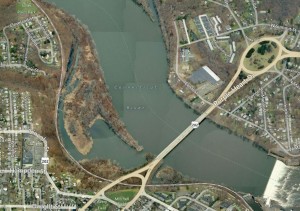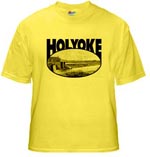by Laurel | October 30th, 2014
29 October 1922

Holyoke’s River Island in 1911
From Richard’s Standard Atlas of the City of Holyoke, Springfield, Mass., 1911
Click through on image to enlarge
Boston & Maine Railroad and Waterpower Company Rival Claimants
It Really Isn’t An Island at All
Question is Whether it Will Become a Park Site or Furnish Location For More Mills
Who owns Holyoke’s “island,” that long level wooded piece of and that stretches from in front of the Holyoke ice house, curving with the blue waters of the Connecticut to the mainland above Jones Point? One claim is that the Boston & Main Railroad owns it. The Holyoke Water Power Company says flatly that it owns all the land that the season’s recurring floods have deposited, and that the Boston & Maine, which was the Connecticut River in those days, bought a right of way only.
The island is not an island at all now, although it was in the beginning. It is connected with the mainland by a broad meadow over which, as over the island itself, sweeps the flooded Connecticut nearly every spring, leaving a thin film of sediment like that of the famous Nile — sediment that has built up the island.
Assistant Marshal Haley as a boy, with other boys, gazed with eager curiosity in some early year not known at the first treelet that started to grow, which many people went out to see in boats. If it had been today, with today’s Hooliganism rampant, the small tree that had been caught on the shallowing flats and started to grow would have been pulled up; but it was allowed to grow and others followed. Presently a little island appeared. It grew broader and broader; trees sprang up more plentifully; greensward began to appear along with mud, turtles, muskrats, minks and small boys. Its growth was helped, no doubt, by the piers and boom built by the lumber company of whose plant nothing remains but a gaping mudhole and a bank of refuse.
Growth of Isthmus
Originally the thousands of logs floated down the river to the lumber company, were caught by the outlying boom and poled down what is now solid land, for there was then no connection between island and mainland. Later the lumber company had to string a boom across the river and bring the logs up into the “cove” from beneath the tip of the island.
If you take the main railroad tracks, keeping a wary eye out for the railroad cops, from near the icehouse and following the long “deadman’s curve” Northamptonwards, you will presently come to the narrowing canal to which the wide cove shrinks as it extends north. The gully that comes down from “Sam” Hoyt’s paradise of happy houses and Christian Science debouches upon the railroad tracks just where what appears to be a dike ends. Take this dike and follow the path that is worn smooth and hard by the tramp of many feet, and in a few moments you ae between what appear to be two canals. Across the canal to the right is the “island,” across that to the left are the mainland and the railroad embankment. The smooth and level dike upon which you are walking, with grass as high as your waist on wither side of the path is the original embankment of the Connecticut River railroad used when only one track ran north of Holyoke, over which each spring swept floods which made the line impassable for days. The single track layout also appears a mile or so further up, by the rock cut opposite to the “Dutchman’s” near which also once ran the dam across the river, first built not for power but for navigation purposed. It was this dam that, settling back the waters of the river, overflowed the Northampton meadows and caused a bill to be brought into the Legislature that it be abolished because of the disease and trouble that it made. This caused quite a fight between the river gods of those days and the Meadow City dwellers not wholly unlike that which is raging today over the power question at Holyoke.
But to return to our island. It is across this island from its ti[ to the meadows in its upper section that Treasurer Robert E. Barrett of the Holyoke Water Power Company sees in the future the relaid tracks of the Boston & Main Railroad extending, while ashes and other debris from the mills fill in the “cove” to form sites for a score of mill concerns. Dumping grounds in Holyoke are getting scarcer every year, and it may be that his dream will come true.
Frank O’Connell of Daniel O’Connell’s Sons has a different vision — he sees in it tin the future a great pleasure ground for the people. The cost of a bridge to it has handicapped development, but there are some beautiful spots on the island and much more of it could be made attractive at small expense if the Connecticut river would play in its own channel and not rudely pour millions of gallons over the entire island at every period of high water.
According to legend it was at one time a rendezvous for “hobos” who infested all the territory. Sanguine hunters now and then stamp through the overs; in certain springtime months wise ones who know the ways of the muskrat shoot or trap them by the score. Muskrat skins bring a good price and one nonchalant individual recently declared that a certain ward 4 man got more than 100 skins one season. Certain it is the land is fertile and the undergrowth from the dampness and the rich silt foundation roots luxuriantly every spring and summer. There are acres of fertile land going to waste. Who will be the adventurous farmer to cultivate this neglected seedbed and cause potatoes, squashes, onions and other desirable edibles to grow? The market is close at hand, so there wold be no difficulty in disposing of the product.
“Money Hole Hill”
On the mainland opposite the island lies “Money Hole Hill,” of which the present generation knows nothing, and the memories and legends about which are gradually fading from the older one. It was on this old railroad embankment near the island that a fatal accident once took place in the early days. There had been a big snowstorm, and the snow blown in from the bluff onto the track, had blocked traffic. A gang was at work cutting through the big drift when a snowplow backed by several engines dashed through from the other side without warning, killing several workmen outright and injuring others.
In the spring floods, it used to be a dare as to how long the engineers would run their engines over the submerged track. When the water was only a few inches above the rails the engines would dash through throwing up a shower of spray, but after it had reached two or three feet in depth they generally stopped at one side or the other. More than once and engine left the track; one once leaned up against the rocks opposite the head gate-house like a tire horse; another ran into the little pond just above the sawmill site. Loomotives of the earlier days, many of them woodburners, were pygmies compared to those of today.
The city engineer estimates the acres of the island roughly to be about 25 acres and believes that the original banks of the river were on the other side of the island so the area it occupies is a flooded land and without a doubt a part of the land bought by the water power company long ago. The gas and electric department was given its innings this week in the controversy that exists between the department and the Holyoke Water Power Company and like that company it had printed a pamphlet that set forth its contentions and outlined the power question from the municipal standpoint. There were significant omissions which reflected credit upon the department, and it is not too much to say that the presentation was in apparent good faith, and in both wording and subject matter is in keeping with the spirit in which controversies should be conducted.
The way is not barred to a much better understanding, not only between the two parties at issue, but among the city as to points involved. While minor passages could be criticized, it is evident that the gas and electric lighting managers have agreed upon a less belligerent attitude than that assumed at previous hearings, which will lead to more attention being given the city’s side of the case. this is highly important.
The door does not seem to be barred to coming eventually to a working agreement, although it is yet too early to say that this is in sight. The more both sides are studied by the voters generally and the more the matter is threshed out in detail, the greater the likelihood that the Water Power Company lion and the municipal lighting lamb may yet be found side by side.
Adapted from The Sunday Springfield Republican.









